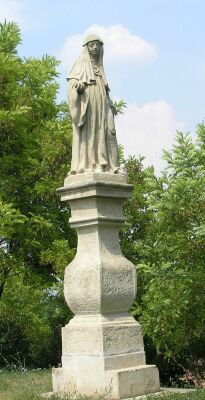Statue of Saint Walburga
Translated by Dóra Lukács
We can admire the Statue of Saint Walburga, erected by János Illésházy around 1789, in Érd-Ófalu, in front of the buttress of the one-time castle.
Saint Walburga was born around 710 AD as the daughter of Richard of England, and she was raised in the nunnery in Winburn with Saint Lioba. According to her legends, she was capable of soothing the tempestuous sea, and when she arrived in Heidenheim, the holy light shined on the convent. She healed the daughter of the lord of the castle, and the dogs didn’t attack her while she crossed the drawbridge.
Saint Walburga is the patron saint of peasants and farmers. Her help is asked for plentiful crops and the growth of livestock, and against dog bites and rabies.
Her depictions are varied but fairly rare in Hungary. The setting of the Statue of Saint Walburga in Érd is not accidental; the abbess’ gaze is turned towards the Saint Michael Church. Her dress was originally dark blue, but now the statue is too worn for the details to be visible. The head was damaged in the Second World War, and the hands were broken off. The statue was renovated in 1999, and in September in the same year it was transported to its original location. Attile Fekete, the student and sculptor-restorer of the Hungarian University of Fine Arts, completed the restoration with Péter Szabó’s guidance. The missing hands were replaced, and the statue once again holds the phial of oil, which is her main characteristic, since oil was seen seeping from her grave.
